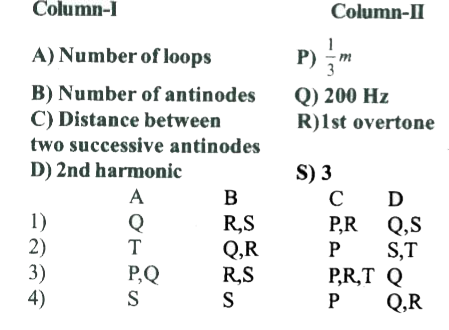The vibrational frequency of a string is 300 Hz. The tension in the string is made twice and the length of the string is changed in such a way that it vibrates with a frequency of 600 Hz. What will be the ratio of new length to original length ?
The correct Answer is:1:1.41
To solve the problem, we need to analyze the relationship between frequency, tension, and length of the string using the formula for the frequency of a vibrating string.
1. Identify the initial conditions:
- The initial frequency f1=300Hz
- Let the initial tension be T
- Let the initial length be L
- The mass per unit length is denoted as ν.
2. Use the frequency formula for the initial conditions:
The frequency of a vibrating string is given by the formula:
f=12L√Tν
For the initial conditions:
300=12L√Tν(1)
3. Identify the new conditions:
- The new frequency f2=600Hz
- The tension is doubled, so the new tension T′=2T
- Let the new length be L′.
4. Use the frequency formula for the new conditions:
For the new conditions:
600=12L′√2Tν(2)
5. Rearranging equation (1):
From equation (1):
300⋅2L=√Tν⟹600L=√Tν(3)
6. Rearranging equation (2):
From equation (2):
600⋅2L′=√2Tν⟹1200L′=√2Tν(4)
7. Equating the two expressions:
Now, we can square both sides of equations (3) and (4) to eliminate the square root:
- From (3):
(600L)2=Tν⟹360000L2=Tν
- From (4):
(1200L′)2=2Tν⟹1440000(L′)2=2Tν
8. Setting the equations equal:
Now we can set the two expressions for Tν equal to each other:
360000L2=12⋅1440000(L′)2
Simplifying gives:
360000L2=720000(L′)2
9. Finding the ratio of lengths:
Dividing both sides by 720000:
L2(L′)2=360000720000=12
Taking the square root of both sides:
LL′=1√2⟹L′L=√2
10. Final ratio:
Therefore, the ratio of the new length to the original length is:
L′L=√2≈1.414
Conclusion:
The ratio of the new length to the original length is √2:1.
- The initial frequency f1=300Hz
- Let the initial tension be T
- Let the initial length be L
- The mass per unit length is denoted as ν.
The frequency of a vibrating string is given by the formula:
f=12L√Tν
For the initial conditions:
300=12L√Tν(1)
- The new frequency f2=600Hz
- The tension is doubled, so the new tension T′=2T
- Let the new length be L′.
For the new conditions:
600=12L′√2Tν(2)
From equation (1):
300⋅2L=√Tν⟹600L=√Tν(3)
From equation (2):
600⋅2L′=√2Tν⟹1200L′=√2Tν(4)
Now, we can square both sides of equations (3) and (4) to eliminate the square root:
- From (3):
(600L)2=Tν⟹360000L2=Tν
- From (4):
(1200L′)2=2Tν⟹1440000(L′)2=2Tν
Now we can set the two expressions for Tν equal to each other:
360000L2=12⋅1440000(L′)2
Simplifying gives:
360000L2=720000(L′)2
Dividing both sides by 720000:
L2(L′)2=360000720000=12
Taking the square root of both sides:
LL′=1√2⟹L′L=√2
Therefore, the ratio of the new length to the original length is:
L′L=√2≈1.414
The ratio of the new length to the original length is √2:1.
Topper's Solved these Questions
- BOOK - MODERN PUBLICATIONCHAPTER - WAVESEXERCISE - CONCEPTUAL QUESTIONS25videos
WAVES
- BOOK - MODERN PUBLICATIONCHAPTER - WAVESEXERCISE - NCERT TEXTBOOK EXERCISES21videos
WAVES
- BOOK - MODERN PUBLICATIONCHAPTER - WAVESEXERCISE - PROBLEM9videos
WAVES
- BOOK - MODERN PUBLICATIONCHAPTER - UNITS AND MEASUREMENTEXERCISE - CHAPTER PRACTICE TEST15videos
UNITS AND MEASUREMENT
- BOOK - MODERN PUBLICATIONCHAPTER - WORK, ENERGY AND POWER EXERCISE - Chapter Practice Test16videos
WORK, ENERGY AND POWER
Similar Questions
A string vibrates with a frequency of 200Hz. Its length iss doubled and its tension is altered till it begins to vibrate with a frequency of 300Hz. What is the ratio of new tension to the original tension ?
View SolutionA string of length 1m stretched at both ends vibrating with frequency 300Hz which is 3 times the fundamental frequency
 View Solution
View Solution
Knowledge Check
- Question 1 - Select One
The lowest frequency of the vibrating string is
AFundamental frequencyBThreshold frequencyCFirst frequencyDa and b - Question 2 - Select One
If the length of the vibrating string is kept constant , then frequency of the string will be directly proportional to
A√TBTC1TD√1T - Question 3 - Select One
If the length of the vibrating string is kept constant, then frequency of the string will be directly proportional to
A√TBTC1TD√1T
The frequency of vibration of a string depends of on, (i) tension in the string (ii) mass per unit length of string, (iii) vibrating length of the string. Establish dimensionally the relation for frequency.
View SolutionIf the vibrating length of a string is increased by 25%, then its fundamental frequency will
View SolutionThe frequency of transverse vibrations in a stretched string is 200 Hz . If the tension is increased four times and the length is reduced to one-fourth the original value, the frequency of vibration will be
View SolutionThe frequency of transverse vibration on a stretched string is 150 Hz. If the tension is increases four times and length is reduced to one fourth of its original value, the frequency of vibration will be
View SolutionWhat tension should be there in a string of length 0.8m and of mass 5×10−3kg, if it vibrates with fundamental frequency of 100 Hz?
View Solution

